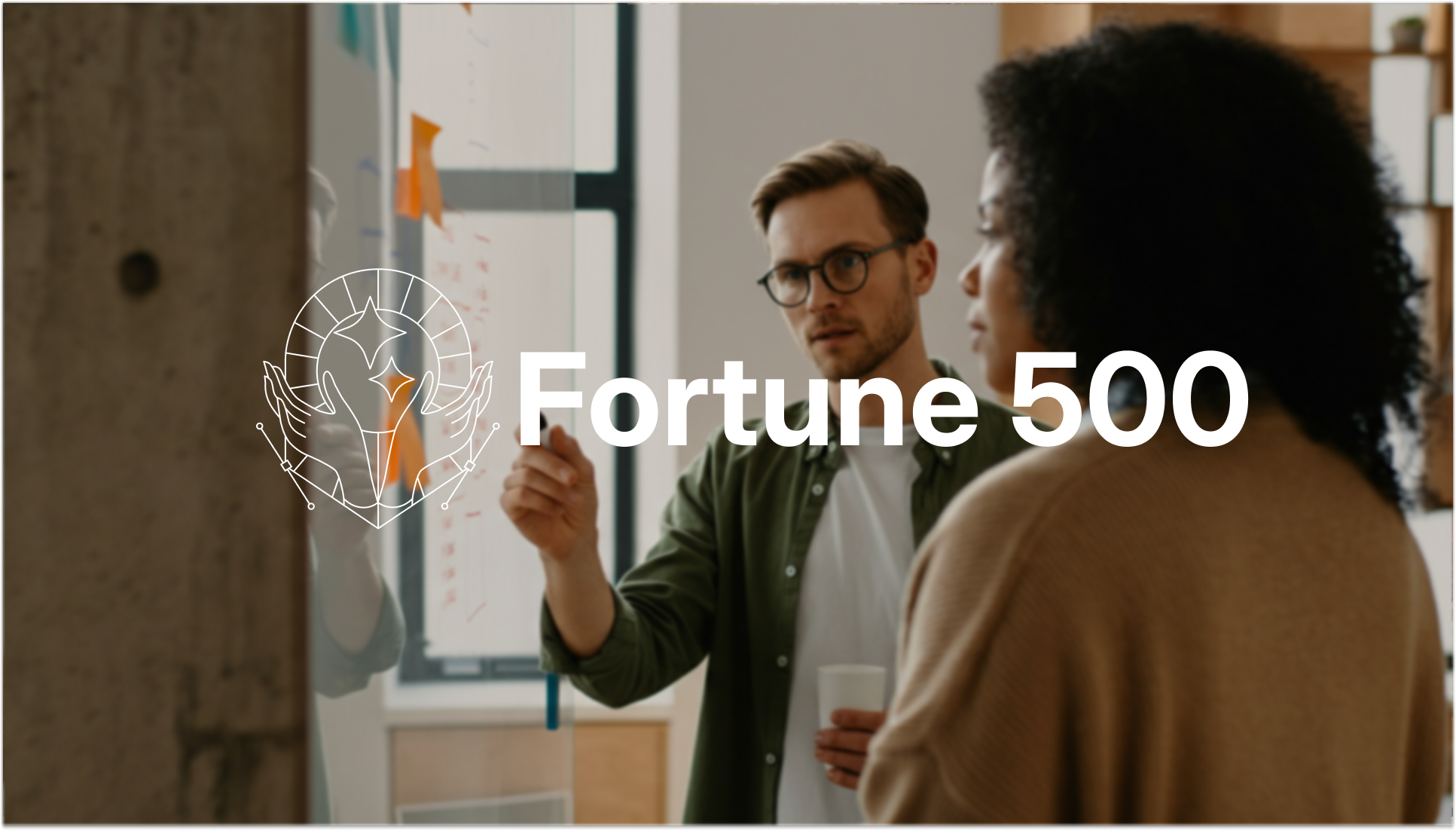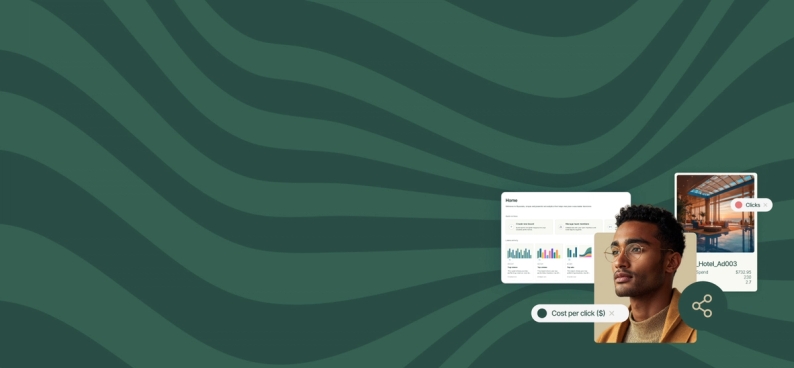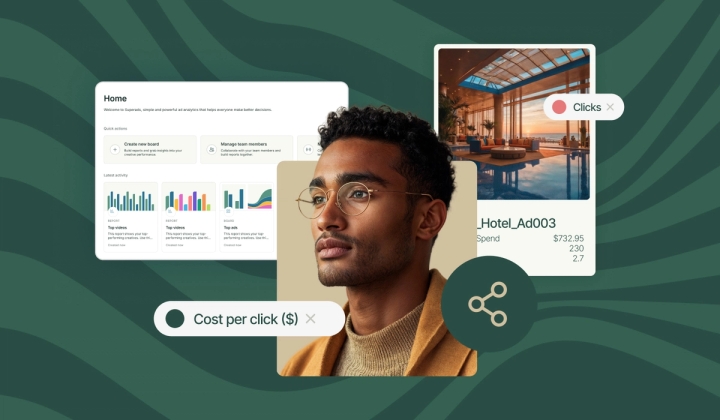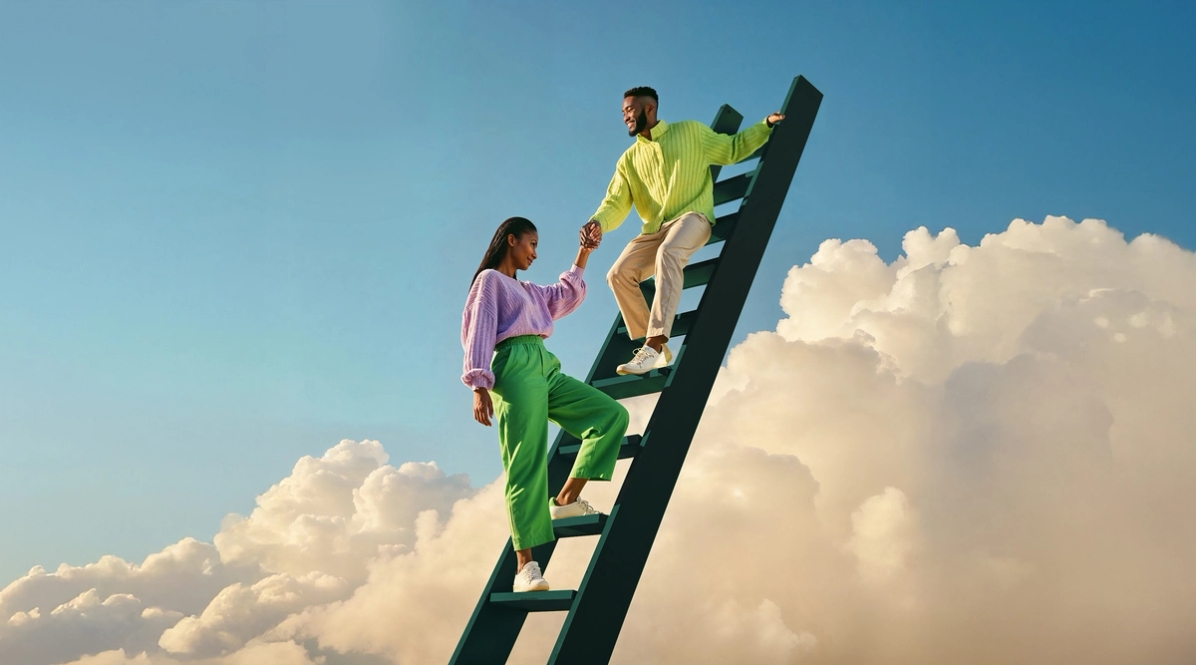
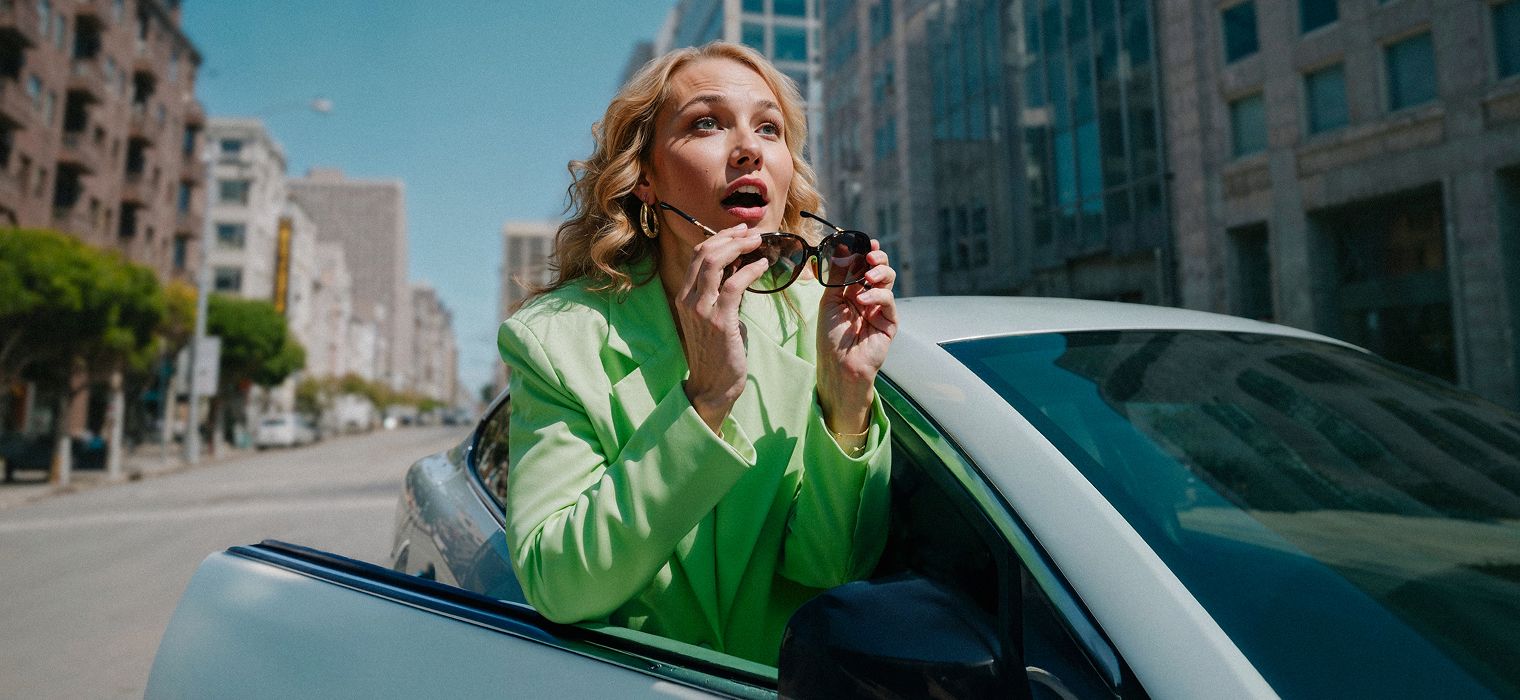
The secret's out: It's chemistry, not just craft
How many times have you pushed a launch this year? Tabled a great idea because you didn’t have the time or resources to pursue it? Wiped the sweat off your brow as yet another ping added to your pipeline?
If this doesn’t ring a big, loud bell, you’re the exception. According to our Overcommitted report, 78% of leaders agree creative demand is higher than their capacity to deliver and 79% want to create bolder work but are always racing against the clock.
Yet bold, awe-inspiring work is everywhere.
At least, as a creative or marketing leader dealing with overwhelming demand and aggressive performance goals, it might seem that way…
But it’s true, despite today’s pressure cooker environment reaching record highs, world-class brands continue to deliver the kind of bold, jaw-dropping, needle-pushing work that makes us wish we thought of that… and wonder, “How did they do it?”
So, we spoke to 20+ creative and marketing leaders at top brands to find out. From Booking.com’s Muppet-forward Super Bowl ad to Typeform’s sizzling Get Real campaign, these leaders spilled their secrets answering big, existential questions, like:
- Where do good ideas come from?
- How can I do more with less?
- How can I maintain quality and creativity at scale?
- How can I make work that people can’t stop talking about?
- How can I prove business impact?
Here’s their number one secret: Great work comes out of great creative partnerships.
Number two: AI won’t replace your team… but it will politely suggest 37 alternative headlines while you’re still debating creative concepts and KPIs.
Number three? Dig into the guide to find out.
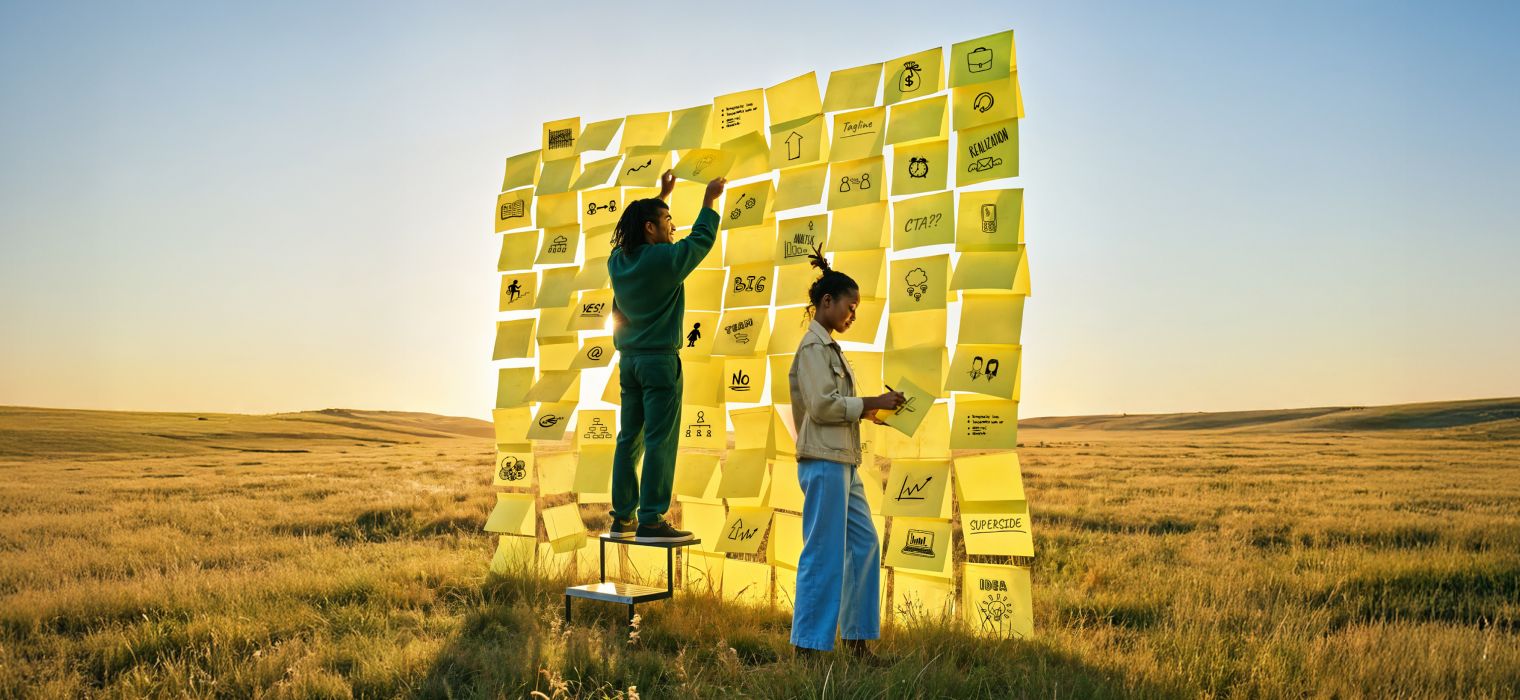
Ideas that stick: Bringing together creativity and empiricism
Before Apple, Steve Jobs tinkered. Before Facebook, Mark Zuckerberg experimented. Before YouTube, Susan Wojcicki dreamed.
But before they became bigger than big, where did their ideas come from?
It might raise more questions than answers, but according to Wistia’s Creative Director, Adam Day, good ideas can come from everywhere. The real trick is creating an environment where each and every person—creatives and marketers, absolutely, but also sales, customer success, engineering and the company at large—feels comfortable coming to the table with ideas, however wacky or wayward they may be.
Because expanding your idea pool, welcoming diverse perspectives, experiences and insights, is how you break out of the same old strategies and break through with truly novel approaches. This also happens to be where AI shines in ideation. As Jessie Hughes, Senior Creative Technologist at Leonardo.Ai, explained, “The principle of ideation starts with coming up with a lot of ideas and then you can play Crazy Eights and down select. With AI, you can lean into this. You can explore loads of variables and avenues very quickly.”
And that speed is essential to both creatives dealing with overflowing pipelines and marketers needing to ideate, test and iterate to find what performs today (not tomorrow) and deliver on goals this quarter (not next quarter).
Of course, the question remains of how to validate whether an idea is “good.” For Cristian Ginori, Marketing Strategy Manager at Superside, it’s all about framing ideas to solve specific problems, or as he put it, “...guiding creativity into results.” Wistia’s Senior Director of Brand Marketing, Taylor Corrado, echoed this problem solving mindset adding that understanding how an idea will land with your audience is crucial.
After all, even the best idea will fall flat in the wrong room.
So, how can you make sure your ideas elicit emotion, provoke conversation and drive action in all the right rooms? Let’s dig into Day and Corrado’s equal parts inspired and practical approach before broaching the expansive topic of AI in ideation with Hughes and Ginori.
On creativity and good ideas
From SNL skits to physical phonebooks, the creative and marketing teams at Wistia find inspiration everywhere.
And both Day and Corrado are firm believers that the best ideas do, in fact, come from all over. The more you open doors to novel sources of inspiration, the more creative and varied your campaign ideas will be. So swing those doors wide open for people across the business, too.
The best ideas come from all over. We get a lot of inspiration from brands outside our industry. And we have a creative inspo channel in Slack where people from all over, not just the marketing team, can share examples of social posts, advertisements, anything related to creative to spark ideas across the team.

Day seconded this sentiment, adding an important qualifier: What does the phrase “best idea” even mean?
Know your goals, tap your wells
The merit of an idea is inherently subjective. So, rather than think about which idea is “best,” Day emphasized the need to focus on which idea is best to achieve the outcome or goal you have in mind. This helps remove some of the subjectivity from the ideation process—though there will always be an element of taste that comes into play. (More on this in a moment.)
The best idea is so subjective. What’s the best idea for the outcome you want? What’s the best idea for the goal?

Day went on to outline three different ways or “wells” where great ideas show up:
- Inspired. Sparked from a conversation, random observation or moment, inspired ideas can be ignited by anything and everything. As Day describes, these types of ideas tend to arrive fully-formed, popping into existence with vision and clarity.
- Data-driven. Prompted by a trend or insight drawn from data, these ideas build on what’s working or capitalize on an opportunity made evident by the story the numbers are telling you.
- Born out of constraints. Whether you have $10 to accomplish a task or three key messages you need to convey, any type of constraint requires creativity to work within, often giving rise to innovative approaches and ideas.
If you understand these three sources and how to tap into them depending on the project at hand, your well of ideas should never run dry.
Validate based on taste, value and emotion
Given a bottomless well of great ideas, determining which ones to pursue may seem daunting. But again, Day has a talent for breaking it down simply. In addition to making sure ideas ladder up to goals, he explained three ways to validate creative approaches:
- Taste. Great taste is hard to define, but plays a key role in creative decision-making. Day and his team use the “smell test” when assessing concepts, based on the taste they’ve acquired by consuming high-quality work throughout their careers. With the proliferation of AI content, Day predicts taste and having great creative curators will become even more important moving forward.
- Value. Is the idea valuable? Is it very clearly contributing something? Whether that’s a tangible asset or intangible benefit, like a moment of levity in an otherwise stressful day, Day suggested asking yourself whether an idea will offer your audience genuine value.
- Emotion. Does the idea elicit an emotional response? Does it make someone cry? Does it make someone laugh? Stopping the scroll is all about tapping into real emotion—that’s when your audience will get drawn in. If there’s no emotional reaction, you’ll likely get no reaction period.
With emotion, comes resonance. Corrado added achieving that resonance is all about deeply understanding your audience—from the problems they face to the humor they enjoy.
Of course, ideas stemming from data might already be validated. Corrado mentioned her team likes to build on high-performing initiatives striving to improve every go around, like Wistia’s ever-popular, annual State of Video report.
A good idea could be something that already performed well, but you’re making it 1.5X better. So, have you done it before and can you make it just that little bit better to resonate more and hit your audience.

Try the pitch test
One last tip when validating ideas: Always be pitching.
If you can pitch it with conviction, chances are it’s a great idea. Day explained how a pitch brings together answers to all the questions you should be investigating when formulating a concept, like whether you considered data points, user behavior, audience preferences and external inspiration.
A pitch brings in the inspiration, the data and any other insights or personal taste you’re bringing to the project. If you can pitch with clarity, if you can argue for an idea, that’s when it’s a good idea.

When Day’s team is presenting a design to a stakeholder, he wants them to be able to explain why all the choices they made were good. So yes, taste may be intangible and design subjective. But as Corrado noted, great taste also means you’re working from a deep understanding of your brand—from aesthetics to values—and that, you can explain in a pitch.
Embrace the unexpected, make ideas your own
Beyond encouraging a good pitch, Day and Corrado are genuinely open to ideas from all sources. So, when a couple designers brought forward the idea of putting together a real, physical book inspired by Hinge’s phonebook campaign, they were all for it.
Some may have balked at the notion—questioned the relevance or the lift. Day said, “Okay, figure out how to do a book, and we’ll do it.” This type of response is part of how he builds a culture where everyone feels safe to share their ideas, which is a topic we’ll dig into next.
The designers went on to investigate book-making on the side, going so far as to visit book printers. And then, sure enough, the right opportunity arose. As part of Wistia’s webinar wizard campaign, Day and Corrado’s teams put together a beautiful 80-page webinar guide book that has now shipped 700+ copies around the world, driving over 1000 downloads and 40,000 page visits.
The book was meant to be an inspiration for people running webinars and a way to get out of the digital world for a minute. Similar to the Hinge campaign, which was a way to get off your phone and interact with people in the real world. We built off that idea.

What if it hadn’t worked? Well, Day and Corrado have some thoughts there too…
Build trust and break down fear
Even working from a deep understanding of your brand and audience, Day and Corrado know not every idea will be a smash success. They both shared instances where a creative idea didn’t fully land in practice, but where they learned lessons along the way, including the importance of challenging your own assumptions and letting your team try, experiment and fail forward.
Because as Day said, “Working scared is the death of creativity.”
When he shared this thought, Day was speaking to fostering an environment where creatives aren’t afraid to speak up—a topic he feels quite passionate about. Whatever department you work in, chances are you’ve experienced moments when you were criticized or penalized for sharing a thought or trying something different. Day knows these moments can stick with you, seeding doubt, fear and reluctance to put yourself out there again.
That’s why Day and Corrado do their best to build an environment where their teams feel safe and supported, breaking down fear and swinging open doors to collective ideation. How?
- Lead by example. Jump in first and often with ideas, however out there they may be. Say things like, “This is a really silly idea, but I need to get it out of my head to get to the next idea.” Leading by example extends to being encouraging in every context. Get excited about your team’s ideas and be loud about that excitement. Day added that he tries not to put a rigid process around ideation either. Letting it happen organically and in many different ways, rather than forcing a Miro board or brainstorm every time, allows team members to ideate and share in the ways that work best for them.
- Make it happen. Demonstrate that a good idea can come from anywhere by not only encouraging those in non-creative or non-marketing roles to share, but making their ideas happen when they do. The more people see others not only sharing, but having their ideas actually actioned, the more they’ll feel empowered to contribute their own thoughts, too.
- Give ownership. In the event a team member is scared or timid, convey that they have ownership of a project and work with them to take responsibility. That includes placing your trust in them and giving them the opportunity to experience both wins and failures—and if they do stumble, support them. Knowing their job isn’t on the line if they have a bad idea will help build trust and that feeling of safety that’s so crucial for creativity to thrive.
- Ask! If someone isn’t speaking up in a brainstorm, ask them for their thoughts. As Day reflected, “We’ve all been in meetings where our heads were full of ideas, reactions and opinions, but we didn’t speak up.” Give people an opening to contribute, and if they don’t have anything, no problem. Just asking shows you value everyone’s input. Extend this practice to asking for feedback from peers and colleagues across your organization. The creative and marketing teams at Wistia hold office or virtual office hours where coworkers can drop by, share work in progress and get feedback, which gives people a smaller setting to contribute and build confidence that they can bring thoughts, challenges and out-of-the-box ideas to the table in the future.
- Establish trust. All of these approaches are designed to build trust. Once you’ve established that foundation, you might consider discussing hang ups or fears with your team members directly. As Day noted, negative experiences really do stick with people, and he sees the instinct to hold back in a lot of creatives. In these instances (once trust is established!), having a conversation about fears and working on breaking that down with them may be appropriate.
Day summed it up succinctly, “All of these practices build trust that as a leader you want your team members to grow, which helps them in their careers and also encourages them to contribute their absolute best creative work.”
“Plus one,” said Corrado.
And that’s how this creative and marketing leadership duo build an environment where great ideas can, and do, come from everywhere.
On AI’s role in ideation
These days, there’s another brainstorm partner in the room worth discussing: AI.
Both Jessie Hughes, Senior Creative Technologist at Leonardo.Ai, and Cristian Ginori, Marketing Strategy Manager at Superside, point to rapid iteration as the primary power of AI in the ideation process.
A lot of the point of generative AI is iteration. It’s having iterative, variable, constantly-evolving and changing imagery, which I find very helpful for improving or getting closer to a good idea.

Hughes and Ginori agreed volume trumps quality at this stage. Not all the angles or visuals AI shares are going to be great—maybe not even most of them. But when you’re ideating, volume is very important to start. Simply by seeing or considering 64 options instead of four, your work gets better, as you get closer to understanding what you need and the best way of accomplishing that.
AI gives you a lot of angles fast. You don’t have to develop them all further. You can go through them and have that human interaction of ‘Okay, what’s the best way to go, what route should we take.’ It’s a brainstorm partner.

But beyond increasing speed and expanding possibilities, what’s the best way to ideate with these tools?
Exploration vs. systematization
At the heart of both design and marketing is audience insight. But applying those insights to our respective crafts happens in different ways. And these ways mirror how Hughes approaches ideation with AI versus how Ginori leverages these tools in his work.
For Hughes, the creative process starts with the seed of an idea. The next step is creative research—putting together mood boards and reference images, as well as exploring effective applications of a concept for a specific audience. Enter Flow State, a feature in Leonardo.Ai designed for the ideation and exploration phase of the creative process.
Flow State is completely for concepting ideas. It’s kind of like a real time generative Pinterest board that’s bringing your ideas to life directly in front of you.

Flow State works like this: Hughes types in a basic prompt, say “a pink, fluffy shoe,” and Leonardo.Ai instantly generates a feed of images based on that starting point, covering a lot of variety from angles to mediums. By pressing a “more like this” button, she’s able to generate an entirely new feed of images based on her selection.
I can keep diving deeper and deeper, going down rabbit holes for ideas. It’s a really fun way of getting visual references or imagery based on what I’m seeing in my head, rather than what’s out there in the real world.

This feature allows Hughes to take what’s inside her own mind and bring it to life with speed and ease. For Ginori, that speed and ease comes from creating systems.
In his work for Superside, he develops marketing strategies and campaign plans for multiple customers often working within constraints, like tight deadlines and limited resources (sound familiar?). To deliver results under these conditions, Ginori and his team needed to create scalable, repeatable systems, which happens to be the exact context where AI thrives.
Since a big part of Superside’s ethos involves being on the cutting edge of AI, Ginori and his team’s adoption of this technology started back in 2023. It goes without saying AI has evolved at a break-neck pace, and Ginori shared his team has gone from moving 10-20% faster back then to 50-60% faster today—both due to the improvements these tools have seen and the systems his team has developed to apply them.
Superside is always on the edge of AI. At first, we moved 10 to 20% faster and then it went to like 30 to 40%. Now, I could say it’s like 50 to 60%. We’re delivering campaign plans in even a week if we already have the context for the customer, the framework done.

So, what do those systems look like in the context of ideation? Ginori explained there are two parts to it:
- The master framework. Usually, blanket solutions don’t apply. But it’s true, there’s universal information every single marketing strategy or campaign should take into account, like target audience, competitive landscape and brand values. Essentially, all of the questions that need answering to develop an informed, results-driven strategy are included in this master framework. Since Superside delivers strategic support across creative mediums and channels, this framework is further broken down by initiative. For instance, if the brief is to deliver a high-impact video campaign, there’s a section of the framework with questions to answer to develop the strategy. By applying this framework in the ideation phase of campaign development, Ginori and his team ensure their AI partner has the appropriate context to suggest relevant ideas for solving the business problem at hand.
- A custom GPT. Similar to Superside’s Custom AI Image Models, Ginori and his team develop custom GPTs for internal use for every customer (provided they’ve checked the AI enabled box!). They train these models using their master framework, meaning they feed them all the information they have on a customer, from competitors and category to audience and brand. As Ginori explained, “The more we feed it, the more it learns.” So with every project they complete for a customer, the GPT gets better—more efficient and accurate—because it knows more about the brand and the decisions made for that brand in the past.
In addition to these systems, Ginori and his team have a one-pager that breaks down how to use AI across ideation and strategic development, including the output, process, tools and AI steps to take at each phase. This structured approach allows them to not only work faster, but get the best results from brainstorming with AI, ensuring ideas tie back to specific business problems.
On the marketing side, it’s about creating a system to guide creativity into results. What’s the business problem? The communication problem? The marketing problem? Ideas are great, but we need to frame them in a way that really solves the business problem.

Always be pitching, part two
Another way Hughes uses AI to help with creative ideation?
She opens up ChatGPT as an app, talks to it using the voice function and pitches ideas. She shared the example of pitching a movie to it the other day, speaking to it just like she would a friend. Then, she asked it to articulate her idea in a way that would be easy to pitch to other people. It came back with a synopsis and logline, bringing clarity to her train of thought.
It tightens up the way others can be brought into my ideas. So for me, I use these tools as riffing boards and collaborators in the same way I would use a friend as a collaborator. I engage with these tools to gain clarity around my own ideas.

For both creatives and marketers, the value of this type of real-time, any time idea refinement exercise is clear. Either you’ll learn an idea doesn’t stand up to scrutiny, or you’ll gain the strategic conviction and communication chops you need to pitch it in real life.
Happy accidents fuel creativity
As we’ve touched on, AI expands possibilities, and that can lead to some happy accidents…
Hughes shared an example where she was trying to come up with a design for a graphic t-shirt—her idea was to show an eagle with its wings up doing a skateboarding trick. As she was generating images, the system accidentally put a second skateboard on the eagle’s other leg.
The visual was so much stronger than my concept of having one skateboard. Think about the visual design of two wings, two feet, two skateboards. Much stronger. It helped me elevate my creative concept in a way I hadn’t thought of.

So, far from limiting or stifling creativity, Hughes swears by the power of AI for fueling it. She encourages everyone to lean into those happy accidents—lean into the expansion of possibilities AI offers—because at the end of the day, it can make your ideas even better.
Of course, Hughes took that idea of an eagle with two skateboards and refined it, ensuring the style and aesthetic of the final image aligned with the creative brief. Which brings us to another key point: As Ginori put it, “AI is not an output tool. It’s more of a process and streamlining tool.”
Control and refine AI’s output
AI gets a bad rep sometimes, but the problem isn’t with the tool. As Ginori explained, the problem is when people use, “the information coming out of AI as the outcome instead of as guidance.” Especially in the research and ideation phase, you need to refine and validate the accuracy of the information AI comes back with.
The same premise applies to creative work: A generated image needs refinement and post-production by real humans before it’s ready to ship.
To get as close as possible to ready to ship ideas and assets, Hughes and Ginori both stress the importance of providing AI with as much strategic information as possible. If you sit down at your desk and send a one-liner to ChatGPT asking for creative ideas, the results will be far from inspiring. If you sit down and do the thinking—share structured information on audience, pain points, past campaigns, brand tone and more—the output will come from a different universe entirely.
It’s all about input. The way I see it, I’m the brain and AI is the hands. So now, what I focus on is being very precise about what I need, how I need it and how I frame it.

Understand how AI supports the dual mission
Creatives need more time to ideate and create. Marketers need more time to strategize and more assets to test, iterate and drive results.
AI supports this dual mission, but not just through expedited execution. Speaking to collaboration, these tools can provide a window into each others’ minds. Ideating collectively has never been easy, but AI can help us do everything from communicating more clearly to acting as a single source of truth for a brand or campaign. All of these benefits bring creatives and marketers into greater alignment, which ultimately leads to better work.
Gen AI allows me to show everybody else what’s going on inside my head. When we talk about teamwork, what an incredible skill to be able to bring others into our creative minds.

Ideate expansively and without fear
The throughline of these stories from Wistia, Leonardo.Ai and Superside? The more ideas the better.
At Wistia, a safe, open creative culture enables every team member to come to the table with ideas, leading to innovative approaches and high-impact campaigns. Meanwhile, Leonardo.Ai’s and Superside’s experts demonstrate how AI can expand possibilities even further when used strategically as a brainstorming partner, riffing board or iterative exploration tool.
As Day would say, the key is to not be afraid: Of the tools, of the evolution of our crafts, of sharing our ideas or opening the doors for others to do so.
Related resources:

Doubles strategy: Executing with precision under pressure
There’s a moment on every creative and marketing team when all those big ideas you dreamed up run into reality.
Ambitious goals. Lean teams. Tighter timelines than ever. And yet, the work still needs to get done—and done well.
For Jennifer Rapp, Chief Marketing Officer (CMO) at Superside, that moment came when she joined a company ready to evolve. “We had grown into a company that had the best enterprise brands in the world as customers,” she said. “But our brand still reflected who we were five years ago, not who we were today.”
The rebrand that followed was bold in more ways than one. No agency. No bloated budget. Just Superside using Superside—and committing to an AI-first approach from day one. “We wanted to be the case study of what an AI-first brand system could look and feel like,” said Rapp. “And what that means is we’ve trained a model on who we are as a brand... that model can now produce work at a rate and speed not possible before.”
On the other side of the creative spectrum, Typeform’s team faced a different version of the same challenge: Skyrocketing demand, limited headcount. But rather than sprinting endlessly, they built systems to scale intentionally. “We only have two internal designers, one copywriter and me in operations,” said Tess Ramsey, Creative Operations Manager. “That’s kind of the biggest blocker sometimes... so we work with an agency to flex our capacity when we need to.”
Both stories highlight a core truth: Doing more with less isn’t about shortcuts. It’s about working smarter—through intentional collaboration, well-designed systems and the strategic use of technology.
So, let’s take a look at how the creative and marketing teams at Typeform and Superside tackled the same question—how can we do more with less?—from two different but complementary angles. One by refining operations, prioritization and partnerships. The other by rethinking the brand from the inside out with AI. The result? Scalable creative models that make the most of available resources.
On scaling creative output through systems, collaboration and partnerships
When creative demand spikes but team size stays lean, many marketing and creative leaders face a common dilemma: How to scale quickly without compromising on quality.
At Typeform, a tight-knit internal team is navigating this challenge head-on—by building intentional systems, fostering deep cross-functional collaboration and partnering strategically with outside creatives.
Intentional trade-offs: Impact over quantity
For Dalton Nascimento, Typeform’s Senior Paid Marketing Strategist, high performance doesn’t mean chasing volume for volume’s sake.
We really prioritize what we believe would have an impact instead of just requesting a lot of stuff for the sake of quantity.

As someone who requests a large share of video assets, Nascimento knows the demands he places on the creative team are intensive—both in timeline and production lift. That makes prioritization essential.
The tension between wanting to push creative boundaries and the realities of limited time is a familiar one across the industry. As noted earlier on, 79% of professionals say they want to create bolder work, but are always racing against the clock.
From the creative side, Dimitra Papastathi, Typeform’s Principal Brand Designer, is quick to underline that alignment—not output—is what unlocks scale. “We’re looking a lot into consistency, but not just in terms of repetition. We’re making sure everyone has the same understanding about brief requests and marketing goals,” she explained. That means not just delivering the right file, but working from the same assumptions about campaign strategy and testing plans.
While many teams fall into a transactional rhythm, Typeform’s approach is different. Creative and marketing act as collaborators from the start, not as siloed requesters and executors. And it all starts with a scalable system.
Building a system that scales thoughtfully
To scale sustainably, Typeform invested in building structured processes for creative operations. One of the most impactful? A tiering model that allows the team to categorize projects by complexity and creative involvement—not by scope, but by the level of creative thinking required.
“Some kinds of projects we know don’t need a creative review—they can just have one stakeholder review and go out the door,” said Tess Ramsey, Creative Operations Manager. “Others might need full art direction. More complex creative work such as art direction often means we put more eyes on it from a creative or brand perspective.”
Here’s how the tiering system breaks down:
- Tier 1 – Campaigns and more strategic initiatives requiring a concepting or art direction phase. Examples: Brand campaigns, high-impact events.
- Tier 2 – Net new creative that doesn’t require a unique art direction. Examples: Always-on work like new paid ad creatives, emails, landing pages.
- Tier 3 – Simple adjustments to existing creative. Examples: Reformatting, minor text or color changes.
The tier impacts several aspects of creative workflow:
- How early the project must be briefed in.
- The type and depth of information needed in the briefing template.
- The number of review rounds and the level of stakeholder involvement (e.g., executive review, creative lead involvement).
- Resources and level of effort assigned, determined during monthly planning.
This model is paired with a point system—where one point equals one day of work—to guide monthly and weekly planning. With that clarity, the team can better manage capacity and avoid burnout. The tier of a project helps define the process it will go through, while the points framework helps determine the scope and resourcing needed to complete it.
Using a tiering system to define how we handle different kinds of projects has made a huge difference.

The tiering and point systems also give room for “foundational work,” as Papastathi calls it: Creative-led initiatives that originate inside the design team. “We aim to balance the work that is initiated from a creative perspective versus marketing requests from our collaborators,” she said. “This also helps allow time for our own initiatives.”
When—and why—to bring in creative partners
Scaling through systems is one part of the puzzle. Scaling through strategic partnerships is another. Even with smart systems in place, the team knows when it’s time to bring in outside help. “We’re a very small internal team,” said Ramsey. “We only have two internal designers, one copywriter, and me in operations. So we work with an external agency to up or down our workload.”
Their goal when looking for an agency? Finding a partner that acts as a true extension of their internal team and is open to receiving feedback. For Papastathi, that openness is non-negotiable.
It’s better to have a not-so-good first delivery and a great second one because the agency is receptive to feedback—rather than the other way around.

Staying aligned, staying curious
While systems and partners help enable scale, the real glue is the collaborative relationship between marketing and creative. Cross-functional alignment is a recurring theme in the way Typeform operates.
Nascimento’s team holds quarterly planning meetings with creatives to review performance and align early on upcoming campaigns. “We discuss all creative requests on a weekly basis and decide what we believe are the most impactful to prioritize,” Nascimento shared.
Ramsey added that creative input isn’t only welcomed—it’s encouraged. “Sometimes marketing teams don’t realize they could submit a more open brief,” she said.
With Nascimento’s team, we’ve been exploring together how open briefs can still spark creativity. Open briefs can sometimes leave space for more creativity than a more closed or prescriptive brief.

Scaling smarter with tools and AI
Beyond people and processes, Typeform’s team has embraced tools that let them do more without compromising quality.
“We shot a video for TikTok and wanted to use it on other channels in landscape,” Nascimento recalled. “The creative team recommended using an AI tool to reformat it. It worked—and saved us from reshooting the whole thing.”
Papastathi sees AI as an amplifier, not a replacement. “We try to use AI with intention. It’s not about doing things faster just for the sake of it. It should boost our creativity—not dictate it.”
Even as tools evolve, they agree on one thing: Creativity needs space. “We try to optimize everything, but creativity doesn’t come from efficiency,” Papastathi said. “If we just keep running, we’re going to exhaust ourselves. We need to stop a little to be able to run faster later.”
On unlocking creative scale and speed with AI
Speaking of running faster, the pressure to scale high-quality creative assets is a fact of life for creatives and marketers. And that tension is especially visible when a company undertakes a rebrand—a massive, cross-functional, high-stakes effort where speed, scale and precision must coexist.
At Superside, these pressures came to a head in 2023. The company had rapidly evolved from a design production service into a full-scale creative services partner for enterprise brands. But the brand itself hadn’t kept up. Internally, there was growing recognition that the visual identity no longer reflected the caliber of customers Superside was serving—or the type of creative innovation the company was capable of delivering.
The old visual identity didn't reflect the brand it truly is, which is a company full of people that are really senior, really experienced and come from some of the top companies in the world.

What followed was a rebrand unlike any other—not only because Superside became its own client, but because it committed to going AI-first. No external agencies. No bloated timelines. Just a small, nimble, hybrid team of marketers, creatives and AI tools working in lockstep toward a single goal: Deliver a fully reimagined brand system that would resonate with enterprise buyers and demonstrate Superside’s unique ability to do more with less.
So, how did it all get done?
Evolving to meet the enterprise opportunity
Insights from a significant research effort—interviews with over 200 marketing, brand and creative leaders—pointed to a clear opportunity: Reposition Superside to meet the needs and expectations of modern enterprise marketing teams.
The takeaway: Though speed is paramount in today’s environment, with a high-stakes project like a rebrand, taking the time to balance that need with deep research is always advisable. Plus, with thorough insights in hand, execution becomes that much faster, as decisions can be made quickly based on clear strategic foundations (as we’ll see in a moment).
Internally, there was alignment from day one that the rebrand would be executed in-house, using Superside’s own services and platform. This was both a proof point and a strategic decision.
It was such a great narrative to be able to say Superside used Superside for their own rebrand. And plus, our internal teams would’ve been disappointed if we had done it any other way.

The creative–marketing partnership, evolved
One of the key drivers of the rebrand’s success was the seamless collaboration between creative and marketing leadership. Weekly syncs, fast decisions and a clear strategic north star allowed the team to move quickly. The process mirrored how Superside works with its own customers—tight collaboration, structured feedback loops and flexibility at every stage.
Our leadership team was really quick to make decisions, they fell in love with one of our directions early on, which is now the basis for our brand.

With internal alignment secured early on, the team was able to quickly move through brand territories, concept development and visual exploration. AI tools were introduced from the beginning—not to replace human creativity, but to accelerate and scale it.
Human creativity at the core, AI at the edges
Rather than replace human work, AI was used to expand on it—dramatically. The team used human judgment to define the foundations, from color palette and design principles to core imagery. Then, AI stepped in to generate faster iterations and scale the output across Superside’s assets.
We used talented humans to lay the foundation of our brand... then we used AI for fast iteration and built out key visual components like brand imagery. That's where a lot of the speed came from.

But AI wasn’t just used for design. It became an engine for experimentation and brand expression. The cost and time savings created space for more strategic brand work. And Superside’s approach wasn’t just experimental—it reflected growing industry optimism. In fact, 96% of creatives say AI can help teams move faster and 93% believe it improves design quality.
We’re allowed to do those things fast, without draining the team’s bandwidth. That just wasn’t possible before.

Perhaps the best example: A brand photo shoot in Cape Town with a twist. Superside captured real images of their astronaut mascot, then trained an AI model on those photos. That model is now used to generate custom, on-brand photography—instantly.
We now have photos for 12 months that are totally on-brand, trained on our imagery. It unlocks creative capacity that would’ve been too expensive before.

A brand that performs
Thanks to a co-creative model with marketing, creative and AI working in close alignment, Superside’s rebrand was completed in six months—comparable to Rapp’s past rebrands at high-growth companies like DoorDash and Klaviyo, but without an agency and at a fraction of the cost. But the real measure of success? The numbers.
Our enterprise business has shifted. 90% of our Q3 revenue pipeline is enterprise. That was the goal, and we’re seeing it work.

For creative and marketing leaders, the lesson here isn’t just about execution. Superside’s rebrand catalyzed a mindset shift across its creative and marketing teams, ingraining AI adoption into the culture and empowering not just speed, but exploration. For Rapp, the takeaway is clear: If you want to do more with less, don’t just delegate AI exploration to your team—get in there yourself.
Start playing. Demystify the tools. Even if it’s just for storyboarding or first drafts, use them to get familiar.

Build a model that supports speed and quality
The stories from Superside and Typeform show scaling creative output under pressure isn’t about doing more with brute force—it’s about being smarter with the resources you have.
Whether by embedding AI into the creative process, establishing clear systems and workflows, or deepening the partnership between marketing and creative, both teams demonstrate that high performance is possible without compromising on craft. The path forward isn’t about choosing between speed and quality. It’s about building a model where both can coexist.
Related resources:

The creative puzzle: Solving for quality and consistency at scale
That model—the one where speed and quality can coexist at scale—starts with brand foundations.
Systems, workflows, partnerships and technology can help you execute at the speed needed in today’s competitive landscape. And these elements play a role in supporting the quality of your creative output. (Yes, AI too!)
But as Cate Williams, Marketing Strategy Manager at Superside, explained, “When you’re looking to do anything at scale, you need to have one source of truth, a foundation to come back to. The brand is the one source of truth. The absolute foundation from which everything gets built.”
For a brand like Booking.com, these foundations allow them to scale and ship thousands of visual assets around the world, while maintaining impeccable quality and consistency—all with a lean in-house creative team. “The brand is our north star. The thing that everyone’s aiming for. It sets out the narrative of who we are and creative aims to match that. If we’re telling the story right, we’re hitting that consistency,” said Daniel Bell, Booking.com’s Design Manager of Brand.
So, how do you build rock-solid brand foundations? Both Williams, as a marketer specialized in developing brand strategies for some of the world’s biggest, most ambitious companies, and Bell, as a creative brand lead for a global household name, are well-positioned to help answer this rather large question.
And of course, for those looking to lead the way, that question extends to the role AI can play in both supporting brand consistency and enabling even greater quality at scale. From custom models trained on your brand to ChatGPT’s deep research function, Superside’s Phillip Maggs, Director of AI Excellence, and Monica Romaniuc, Senior Product Marketing Manager, make a persuasive case for integrating AI into workflows sooner rather than later.
It’s all part of the creative puzzle—let’s take a closer look at the pieces.
On the power of brand
Bell calls it the north star. Williams calls it the one source of truth. It’s clear they’re of likemind when it comes to the key nature of brand, especially in the context of scaling creative campaigns in a consistent, high-quality way.
If you want to make ice blocks, you need to have the mold first before you can make 10s and 1000s of blocks. Brand is essentially that mold that allows you to scale effectively both cost wise and consistently in terms of how you look, how you sound, all of those things.

Another point of agreement: Those foundations need to be documented, (over)communicated and co-owned. This documentation will look a bit different depending on which side of the creative or marketing fence you’re on, though it should all come together as a cohesive whole. Here’s what Bell’s and Williams’ respective pieces look like.
Building brand foundations: Guidelines, principles and bibles
Simplicity empowers consistency at scale—a fact Booking.com uses to their advantage with a minimalistic brand identity that includes their core blue, logo and typography. As Bell explained, these elements are non-negotiables and show up in all their assets, shaping their globally recognizable look and feel.
Think of these core elements as the edges of the puzzle defining the boundaries of the brand. The full picture gets filled in with what Bell calls “creative principles,” an extension of their brand identity that allows for more flexibility while supporting the mission of consistency. To sum things up simply, Booking.com style, Bell’s team works off two documents:
- Brand guidelines. The core, non-negotiable elements that make up Booking.com’s brand.
- Creative principles. An extension of the brand guidelines covering everything from tone and humor to shooting style and set dressing.
The creative principles are the flexibility within the framework. That’s where we find creative ways to bring forth narratives and stories.

With this framework established, Bell and his team are able to walk both internal and external partners through the details empowering everyone to achieve brand consistency, which is key for their lean creative unit. As Bell explained, “The brand studio team is 10 people, so we need to rely on others to help us get it right.”
Bell has a few other tricks up his sleeve when it comes to ensuring everyone gets on board with Booking.com’s brand identity. But before moving on to how best to educate stakeholders, let’s define brand guidelines from the marketing perspective.
In Williams’ work, she develops brand strategies, handing off what she calls a “brand bible” at the end of the day. That bible includes three key lenses:
- The audience lens. A detailed breakdown of a brand’s audience, including what they need, what they want, their barriers and frustrations.
- The competitor lens. An in-depth review of the competition, including how they’re going to market, how they’re speaking to their audience, how they’re dealing with barriers and frustrations, as well as what gaps and opportunities exist. This is where competitive differentiation is established.
- The business lens. The business objectives of the brand and how they translate into a brand strategy that’s relevant to the audience, differentiated from competitors and in line with company values.
Within this bible, you’ll find key pages covering brand values, personality, tone of voice, as well as what Williams calls a brand core: Why, what and how statements aligned to Simon Sinek’s Golden Circle model. Following Sinek’s brand strategy framework, Williams defines the “why” as your purpose statement—that one simple phrase that should inspire and motivate both a brand’s customers and employees.
Practically speaking, this will look like a 50-page deck… which might pose communication problems. “Nobody wants to go back to a 50-page document every time they create a social media post,” said Williams. Thankfully, she has some brand education tricks up her sleeve, too.
Empowerment and power slides
When it comes to brand education, Bell’s philosophy is to motivate and empower instead of chase. As he jokingly shared, he didn’t sign on to play brand police. And when people are intrinsically motivated to uphold brand standards—when there’s a shared sense of ownership—you have to do a lot less chasing.
His approach is multifaceted, but it starts with simple visibility. “You need to be visible and approachable. If you’re an open brand team, then people know to come to you and ask questions,” said Bell. To aid in this visibility, Booking.com’s brand studio has dedicated designers for each marketing team, like events and partnerships. Clearly defining these areas of responsibility means stakeholders know who their point of contact is for every project and can address their questions to the right person.
Of course, being an enterprise, there are thousands of people beyond the marketing and brand departments. That’s why Bell and his team endeavor to make their brand guidelines as accessible as possible by “plastering them across campus.”
Sometimes, we'll have almost like mini campaigns around our campus where there'll be banners, and we've got these digital screens everywhere. We might have refreshers like, ‘Hey, we've updated our brand guidelines. Go to brand.booking.com.’ People know that exists.

In addition, Bell’s team put on a big song and dance every time they launch a campaign. To educate the company at large, they’ll put together a series on how the campaign came to life, weaving in the foundational role of Booking.com’s brand guidelines and creative principles. In these instances, they’ll also create a campaign expression deck, which houses approved copy, taglines, aspect ratios, legal guidelines and more—essentially, everything partners need to know to roll out the campaign’s creative assets with consistency at scale.
Internally, Bell shares they “try and shout about it” as much as they can. Whether that’s doing a five-minute spot at an all-hands meeting or going to different teams and discussing their latest work, Booking.com’s brand studio makes their passion and creative convictions clear, seeding belief in the power of branding across the business.
On Williams’ end, she builds that conviction with “power slides:” One to two slides summarizing the brand strategy. Williams recommends including these slides as part of every single project, brief and collaboration to the point where they become ingrained in the minds of both marketing and creative stakeholders, and they’re able to recite them naturally.
I do what I call a brand on a page. When I present the brand strategy to customers, I tell them if you haven’t seen the first 75 slides of this document and you just have this one power slide, which is the key facets of your brand all on one page, then we’re still kind of safe.

Empowering true partnerships, too
Having power slides and documented creative guidelines and principles will go a long way to easing both internal and external brand education. But for a brand like Booking.com with a lean creative team that works with a wide network of vendors and partners to scale globally, just handing off documentation and hoping for the best doesn’t cut it.
Instead, Bell’s team pushes for a true vendor partnership model. In addition to walking new partners through a vendor onboarding toolkit, including their brand guidelines, creative principles and tools and templates, Bell is a strong proponent of “getting in the mud with each other, sharing working files, doing quick check-ins and having standing meetings.”
Because that’s how you would do it internally. And if a vendor is amenable, that’s how they become a true extension of your team, enabling scale without compromising quality.
We lean on agency partners with local expertise to help us scale. For some of these campaigns, we might have 30 different taglines in six languages with 10 images and 12 aspect ratios that need to be rolled out across multiple channels on staggering timelines. So without agencies and without Superside almost like an extension of our team, we just wouldn’t be able to do it.

Flexing within a brand framework, Super Bowl style
Bell shared a notable example of one such campaign where the scale was staggering: Booking.com’s 2025 Super Bowl ad. Not only noteworthy for the iconic Miss Piggy’s appearance, this campaign is the perfect example of getting creative within brand guidelines, or as Bell would put it, “flexing within the framework.”
Though their brand identity is non-negotiable, their creative principles allow them to bring stories to life in new and novel ways. In this instance, the humor the Muppets employ in their ad stems from Booking.com’s creative principles, ensuring that even though this approach is a departure from the norm (as is fitting for a Super Bowl ad!), it still aligns with the brand’s overall personality and speaks directly to their well-researched audience: The booker.
That’s what we call our hero film. It’s the hero but it’s not everything. There’s so much more that goes behind it and all of this is informed by the creative principles. We have the hero, and we roll out all of these other assets. Statics, gifs, cutdown—all tailored for different audiences and markets.

It goes to show, far from being a blocker, brand guidelines or constraints of any kind can ignite creativity. “Creativity is a unique way to solve a problem or present an idea. And so, you almost need those rules because sometimes the best creative comes from the most restrictions. If we need to hit certain points of a brief, hit a certain objective, we need to be creative in how we do that within the guidelines,” said Bell.
He shared another example, this time more day to day, of having to get creative about ways to incorporate Booking.com’s blue in photoshoots. Bringing that core brand blue in naturally isn’t always easy, which leads to creative solutions and distinctive shots.
Williams adds an important qualifier: Ensuring teams understand why a brand guideline is in place and the context behind it can unlock even more powerful creative. A guideline should be related to an audience need or a competitor gap, so having this context is essential to ensure creative ideas resonate with that underlying need or differentiate a brand’s approach.
When you know ‘we’re trying to be different from competitor X because this is how they do it,’ that allows you to unlock a creative thought that might be quite dynamic and challenging in terms of disrupting the market and going after the competitor.

Evolving to differentiate and resonate
We’ve all noticed how over time, our taglines pop up in one shape or another on competitor sites, our out-of-the-box creative concepts start flooding feeds—take it as a compliment and a sign to change directions. As William noted, when the market becomes ubiquitous and you start seeing far too many similarities between competitors, it’s time to update or evolve brand guidelines.
Another sign you’re due for a brand refresh: Your audience is less engaged. Williams explained how a “less engaged, loyal or advocative” audience means you’re losing relevance and resonance. When this happens, she suggests going back to the drawing board and researching how and why your audience has evolved. At the same time, look into your competitors, find any new gaps and plan to take advantage of them to achieve differentiation.
On the creative side, the signs might be more tangible. Bell spoke to struggling with achieving a consistent core blue when putting on events and applying their palette to diverse materials. Or, realizing their logo didn’t lend itself to the small size needed for social-first activations. These practical issues can also spur brand evolutions, whether that’s expanding a palette or developing an icon version of a logo.
In these moments, make sure to come together as marketers and creatives—because as Bell said best, the magic happens when both parties have input into the brief.
Make collaboration on brand
As we’ve seen, marketers and creatives bring a unique yet complementary perspective on brand to the table. And when these parties are equally bought in on each other’s vision, understanding both the research behind a brand and its visual expression, that’s when you’re able to achieve true cohesion and quality at scale.
That level of co-ownership starts with collaboration.
Bell believes in briefs being the beginning of a conversation: “There should be input from both sides in the beginning. If we sit down and talk about what a campaign is going to be, it makes it more successful. Creative might be able to offer input or suggestions into how the campaign could come to life. And in the later stages, just trust the creative team.”
Williams swears by overcommunication: “I’m a huge advocate for overcommunicating. Rather ask more questions, rather more opinions, rather more discussions than less. We need to get into the rhythm of using digital means as a way to collaborate and communicate with peers and creative teams. Because it’s that kind of communication that keeps the collaboration alive.”
So, talk more, trust more and build an environment where collaboration is on brand.
On using AI while ensuring creative quality
A year ago, AI’s primary value was in exploration: The expansion of possibilities we touched on when we spoke about ideation. Whether you’re a marketer using a large language model (LLM) to iterate upon an idea or a creative using an image model to find inspiration, that value still stands.
But now, these tools excel across marketing and creative workflows, providing value from ideation through to production.
If you asked me how AI elevates creative work a year ago, it would’ve been in exploration. In broadening horizons. The maturity of the tools and people using them was towards the front end of the process. Now, we’ve come nearly 180.

Romaniuc concurs. “It adds so much value across every single stage,” she said. From deep research to custom models, AI tools and features have advanced lightyears in just 12 months.
In the conversation about quality, these advances mean everything. They mean you can move faster, scale with ease, layer in expertise, and ultimately, spend more time on the quality of your ideas and strategies rather than executing endlessly. “You should be spending 80% of your time on the quality of the idea because you should be able to produce in 20% of the time,” said Maggs.
The creative caveat: Legacy stacks
Just because a tool is useful across workflows, doesn’t mean you’re able to use it. Maggs pointed out that integrating AI into creative workflows presents a challenge at many Fortune 500 companies where legacy stacks are hard to break out of. Given these dependencies combined with slow-moving approval chains, legal considerations and general misgivings, it’s not surprising only two percent of creative teams have fully integrated AI into their workflows.
That said, Maggs sees the tides changing. As we’ve touched on, 96% of creative leaders believe AI will help creative teams move more quickly and 93% believe it will improve quality. Meanwhile, Maggs revealed that many of Superside’s largest customers are starting to ask about upskilling their creative teams on AI.
Given this inside track, he predicts the creative + AI model will become ubiquitous in the next three years. There may be more layers at an enterprise, but leaders are aware of the opportunity and loath to be left behind. So, how can you ensure you’re not only taking advantage of these tools, but hitting the highest level of quality they enable?
The quality trifecta: Agility, customization and curation
Another thing Maggs and Romaniuc agree on: In the AI era, agility is key.
When asked how to ensure quality while using AI to deliver creative faster and at scale, Maggs’ number one piece of advice was not to get too attached to any single tool. As he explained, “We’ve never lived through a time where there are so many companies and startups and developers focusing on creative tooling ever.” And that means it’s not just possible a better tool or model will come out every couple months, it’s a certainty. Romaniuc seconded this point, sharing that she’s always switching tools depending on the latest releases and updates.
You just have to be very comfortable with switching a lot to be able to maintain quality. Saying okay, here’s my quality benchmark, and I will just stick with this for the next three years with this tooling, training and enablement won’t cut it.

Of course, in the conversation about enterprise stacks, this type of agility can be a challenge. That’s why more and more enterprises are turning to flexible creative partners, like Superside, to act as an extension of their in-house team and stay on the cutting edge of these tools, as well as develop and manage custom models aligned to their brand.
Which brings us to Maggs’ second point: Rely on the parts of AI that are very good at maintaining consistency and quality.
Specifically, Maggs was referring to custom AI image models. Trained and fine-tuned on your assets, these models allow designers to produce usable, on-brand visuals right away, rather than generating thousands of assets only to land on a few worth refinement. Maggs and his team are now offering Custom AI Image Models to customers as a service, speeding up image generation by 10X, which translates to 85% cost savings per image.
But the real magic of these models is their ability to understand your brand, enabling not just scale, but quality and consistency at scale.
Romaniuc also advocated for the use of custom models, speaking to the text side of the equation. On Superside’s product marketing team, they’ve built a Custom GPT that draws on finalized positioning docs, brand guidelines, style docs, personas and vetted research. By using this GPT across teams, they ensure consistency in everything from strategic assumptions to key statistics and brand tone.
We always know it's pulling from the right things, whether it's our persona information or our positioning docs. We know it's always grounding things in that information, which helps with that first level of quality control. Then we add our experts on top of that as well.

The last point on achieving quality with AI is all about that expert level: How and when humans should interact with these tools.
At the beginning of the process, that differs for creatives and marketers. In Romaniuc’s line of work, fact-checking the sources, statistics and statements AI generates is essential from step one. Building a whole strategy based on a flawed statement or confabulated fact wouldn’t lend itself to quality… or efficiency.
But in the creative process, Maggs actually cautions against overrefinement in early stages. As he explained, AI helps you make loads of options quickly, but you shouldn’t expect them to be better than 90% to start and spending time refining them at the point of review is, well, pointless. Simply put, curate first, refine later.
You should know you can get it from 90 to a 100%, but you should only do that on the nine things you’re going to publish, not on the 881 other things. Getting quality is always possible, but you need to know when to bring the hammer down and when to let exploration and diversity of creation live.

The time for creatives to make things perfect comes in post-production—and that’s true for marketers, too. As we touched on, Romaniuc always gets subject matter expert and stakeholder eyes on her output to ensure her fact-checking and assumptions are sound. That interplay between human and AI with experts curating, refining and making final calls is central to achieving brand-informed, high-quality outcomes.
Dream big and empower exploration
AI gives us time to dream bigger and expands possibilities for the better.
Rather than default to fear or apprehension, Maggs and Romaniuc encourage their peers to see AI for what it is: A force multiplier. But rest assured, the force being multiplied is humanity.
At least, if you’re following a similar creative or marketing model as Maggs and Romaniuc at Superside where AI is a tool in their stack, not a replacement for any one person. And that’s the right model for raising the bar—because AI can’t reach the standard on its own, but in collaboration with a human, it can elevate work above what we achieve on our own.
The moral of the story: Don’t over rely on AI, but don’t dismiss these tools either. As Maggs explained, both extremes lead to bad places. Instead, he encourages leaders to:
Empower your best creative brains and give them the psychological safety to go out there and try these new things. Maybe, in the early days it’s not going to be up to your standards, but keep pushing through that pain barrier, and you’ll create an environment where creatives can explore and exploit this amazing new thing and feel good about it, which isn��’t trivial.

Scale quality creative through collaboration
As Booking.com demonstrated beautifully, a strong brand is foundational to scaling quality creative. And as Superside’s experts showed us, AI is ideally suited to supporting brand consistency at scale.
But the secret to success when pursuing these endeavors, building a rock-solid brand and using AI to scale, is bringing marketers and creatives closer together: Co-owning, co-building and collaborating at every stage to ensure a brand strategy aligns with its visual expression—and that both are brought to life in consistent, creative ways.
Related resources:
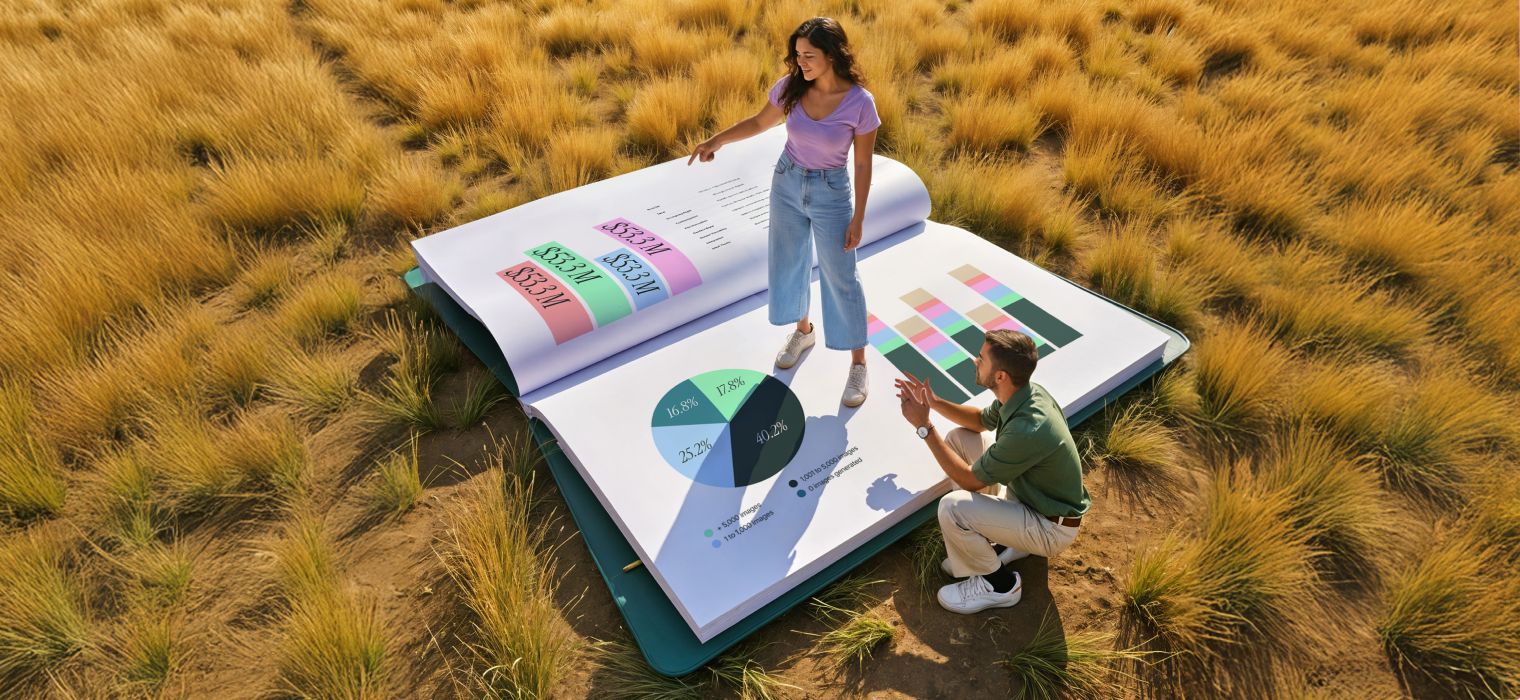
Beyond the bar graph: Making what moves, measuring what matters
Quality is the baseline. But as creatives and marketers, we all dream of making something unforgettable. Work that sparks conversation, drives results and earns a permanent spot on someone’s idea board—or better yet, their quarterly report.
But breakthrough creative doesn’t happen by accident. It takes more than clever ideas or beautiful design. It takes a clear understanding of what actually works… and what actually moves.
At Superside, Piotr Smietana, Director of Brand and Marketing Creative, and Andres Levinton, Co-founder of Superads, know that great ads do more than grab attention—they convert. Their secret? Treating data like a compass, not a constraint. “Instinct is data, too,” said Smietana. “The best work comes when you combine what you feel with what you can prove.”
At Typeform, Meg Gowell, Director of Growth Marketing, and Kevin Branscum, Senior Director of Brand Marketing, echo the same principle from a different angle: Format is as strategic as the message itself. Alongside Superside’s Darren Suffolk, Creative Director of Video Services, they’re focused on content that not only performs, but earns engagement across the funnel.
Both stories show making work that moves people and the business means aligning creative instincts with strategic signals—and choosing formats that deliver more than views. Like what? Let’s dig in.
On using formats that land
There’s no singular formula for breakthrough creative.
But if there’s a throughline, it’s this: The formats you choose matter as much as the message you’re trying to send. In an era where attention is currency, getting the right mix of video, visuals and content isn’t just a nice-to-have—it’s a growth imperative.
To unpack what that mix looks like, we brought together perspectives from both sides of the creative partnership: Suffolk, from Superside’s video team, and Gowell and Branscum, from Typeform’s growth and brand teams. What emerged is a blueprint for value-first thinking that delivers results and drives conversations.
From metrics to momentum: Defining success
What success looks like means different things for different people. Ultimately, it’s about impact.
From the marketing side, that often means metrics. “For me, it’s a mix of on-platform metrics—click-through rate, impressions, signups, form fills. And then slightly downstream, it’s about business impact: Are we seeing a lift in paid accounts or pipeline?” said Gowell. “But also, did we make a shift big enough to teach us something? Whether or not it won, did it disrupt the norm?”
Branscum agreed, adding that success isn’t just performance—it’s resonance.
We define success as getting the anecdotal reaction, engagement and response from people that look like our core audience. Are people sharing it? Are they recapping it in their own campaign reviews? That kind of brand affinity is just as important as conversions.

From a creative point of view, Suffolk brings it back to business impact. “Actual performance and results show you’ve done something worthwhile. Writing what you did is far less compelling than writing what it achieved,” he shared. “That’s always the lens we use at Superside: Did this move the needle for the customer?”
Format is strategy: Why video (still) wins
For all three leaders, video is a critical tool for standing out.
“We’re living in the democratization of constant access to video,” said Suffolk. “It’s no longer true that short attention spans kill long-form. People will give you their time—on the bus, at lunch, between meetings—if what you’re showing is actually worth it. And if it moves, it grabs attention.”
For Gowell and Branscum, it’s all about the funnel stage and where customers are. “You have to keep your finger on the pulse of how people are consuming,” Branscum added. “Some formats work better at the top of the funnel for emotional impact—like video—and others are great for more technical content. It’s about matching the medium to the moment.”
Diversify formats to be able to reach people in the way they're consuming information. That can vary from person to person and by funnel stage. From a creative standpoint, we're always wanting to explore those different formats, but we also want to make sure we're not just creating something that's going to collect dust, but that people on our team are excited to use and explore.

Closing the gaps between teams
One of the biggest blockers to format innovation? A broken feedback loop.
“There’s always a gap between the paid team and the creative team,” admitted Gowell. “It’s hard to aggregate ad performance across platforms. There’s no dashboard. It’s manual. So creatives are kind of blind unless you make a real effort to connect the dots.”
According to Suffolk, making that effort and creating alignment is essential to breaking through the noise. “We’re lucky to have strategists who work to fuel the creative journey, not control it. That’s how we prioritize: Ideas supported by data, but with space to be bold,” he said.
If you copy what’s flooding channels, you’ll blend into the AI noise. Be different. Try something fresh and creatively, instinctively led. Try to find that thing that's still going to resonate but isn't going to be the same as all the other stuff out there.

Making the most of every initiative
Given modern day resource limitations and lean teams, marketers and creatives are learning to align, repurpose and make the most of every initiative.
“At Typeform, creative capacity is often our biggest bottleneck,” said Gowell. “In this ‘do more with less’ era, we look at every initiative and ask: Is this something that I will be able to reuse or is this an isolated moment that I'm not going to be able to use again? Is this campaign something that will live on in some sense?”
A great example: Typeform’s “Get Real” campaign. With a limited budget for ad spend, the team got scrappy. For the first part of the campaign, they created a video-based survey and contracted 37 influencers to take it using Typeform, where they shared their hot takes about influencer marketing. Afterwards, they shared those video responses with their followers, resulting in 1,300 people responding to the survey. To wrap it all up, Typeform recently launched a report with the findings.
That report is going to feed a bunch of zero-click ads. And so it’s creating this more sustainable ecosystem with what we do. I would consider it creative because we had to kill a lot of birds with one stone with that campaign.

For Suffolk, it’s all about creating long-term value, not just quick conversions. This means going a step beyond just creating content to sell and understanding what consumers can get out of each creative interaction.
With whatever video or content you create, there always needs to be a value exchange with the viewer. They’re giving you their time by watching. What are you giving them in return? If the only thing you're giving them in return is ‘buy our thing,’ that's a bad value exchange. If there’s genuine entertainment, information or insight to be taken, that's a good value exchange.

The value doesn't have to be information—it's about the brand interaction having some kind of lasting impact for a viewer, rather than just being a request from the brand.
The creative-marketer partnership: What makes it work?
But what actually drives breakthrough work? Along with the right formats and real value, collaboration plays a key role.
“It can’t be an assembly line,” said Branscum. “You have to bake in collaboration—brainstorms, thought starters—before you jump to production. That’s where the best ideas come from.”
For Gowell, the vision is even bolder: “The dream is to get to a point where the creative team can ship things to the channel owners—not the other way around. That’s where the magic happens.”
Suffolk summed it up: “It’s this whole idea that it’s a partnership, right? Taking that creative journey and recognizing that the collaboration with a marketer helps keep you focused on the purpose of the work.”
On being data-driven
Great campaigns don’t just look good—they perform. But getting creative to yield real business results requires more than just good instincts or a clever tagline.
Being data-driven is just like using data as a creative compass.

In the high-stakes world of targeting enterprise tech, being data-driven isn’t optional. It’s essential. For Levinton and Smietana at Superside and Superads, this doesn’t mean choosing data over creativity—it means using both, intentionally.
The compass, not the map
“Being data-driven, for me, is just like using data as a creative compass,” said Smietana. “Trying to understand what’s working, why it’s working... so I can make braver and safer choices later.”
It’s not about chasing a magic formula or leaning on dashboards alone. In fact, Smietana pushes back on the assumption that being data-driven means being number-obsessed. “People sometimes mistake data-driven for spreadsheets and dashboards. But instinct is data too. Experience is data. Taste is data. When you’ve created 100 ads, you develop an instinct—that’s your own internal dataset.”
You can have all the ideas in the world, but what good are they if you can’t make them work?

Levinton agreed, while bringing in the marketer’s lens: “No one can act just on gut feeling anymore… but at the same time, advertisers shouldn’t be data fundamentalists. Your strategy needs to be based on actual insights—what’s performing, what’s resonating.”
Beyond the metrics: Interpreting the story
Ask either leader which metrics matter, and you’ll get a similar answer: It’s not the numbers, it’s the narrative.
“Yes, we look at CTRs and CPAs,” said Smietana. “But what are they telling you? The click-through rate, for example—that’s literally how people are reacting. Are they sharing things? Quoting us? Commenting? That tells me we hit something.” Levinton seconded this line of thinking. For him, it's about identifying the story the metrics are telling and going from there.
It’s not about specific metrics in isolation. It’s about what story those metrics tell—and what actions you take from them.

As we’ve seen, translating that story for creatives is key for guiding work that gets results. But let’s get real, the thought of looking at numbers in a spreadsheet doesn’t inspire most creatives. Nor does a “2% CTR” mean much in isolation.
Levinton recognized the increasing challenges teams faced and spearheaded a solution: A metrics framework within the Superads platform that puts these types of numbers into context. Superads is an AI-powered reporting tool that analyzes paid social campaigns, helping marketing and creative teams be more data-driven.
A marketer might say, ‘We have 2% CTR,’ and the creative team wouldn’t know what that means. So we built Superads scores—scores like hook, click, hold and conversion—each rated from 0 to 100. That way, anyone can say, ‘Hey, this ad has a 90 hook score—it really stops people.’ That opens up a better conversation.

The key here is giving context to absolute values. When you share meaning instead of just metrics, you open the door for better collaboration between creative and marketing teams based on a shared understanding of what’s resonating beyond clicks.
Test big and take risks to get results
When it comes to testing, both leaders agreed: The era of micro-optimization is over. “Strict A/B testing is becoming less popular,” said Levinton. “What we’re seeing now is a priority on creative volume and boldness over minor tweaks.”
So instead of testing button colors or copy tweaks, Smietana and Levinton advocate for bigger swings. “If you test 10 different creatives and one massively outperforms, now you have direction,” said Smietana. “You can always do things better. You can always release another ad.”
Shoot 10 things at the wall. One might have a CPA of $200, the rest might be $1,000. That’s how you learn.

And again, both leaders agreed there’s no conflict between data and bold creative—it’s a partnership.
Smietana explained, “I always want to start with something that feels risky. I hate mediocrity. Especially now with AI, everything starts to look the same. I want to break that, make people feel something first. Then I ask, how do I make it convert?”
Levinton backed him up:
There’s no battle between data and creative. You need bold ideas. Then validate with data if they make sense.

Bridging the divide: One goal, one team
What makes Superside’s creative-marketing partnership work isn’t just shared tools—it’s shared ownership. Smietana pointed out, “Historically, creatives avoided data. But that’s changing. Our team is actually curious—asking, ‘Why did this work?’ Sometimes the answers surprise us.”
One of the secret ingredients? Celebrating wins together.
As soon as you make it less about performance vs. creative and more about our team making ads that win, it becomes less about who owns the data and more about the impact.

Be bold and get results, together
Making creative that delivers results isn’t about playing it safe or gambling on a gut feeling. It’s about finding the tension between bold ideas and informed execution. Between intuition and insight. Between what people remember, and what drives them to act.
At Superside, that means empowering creative and marketing to share the same metrics—and the same mission. At Typeform, it’s about choosing the right formats to match the moment, and using cross-functional collaboration to turn scrappy campaigns into lasting value.
Together, these teams show that great creative doesn’t just come from inspiration. It comes from integration—of teams, data, formats and feedback loops.
Related resources:
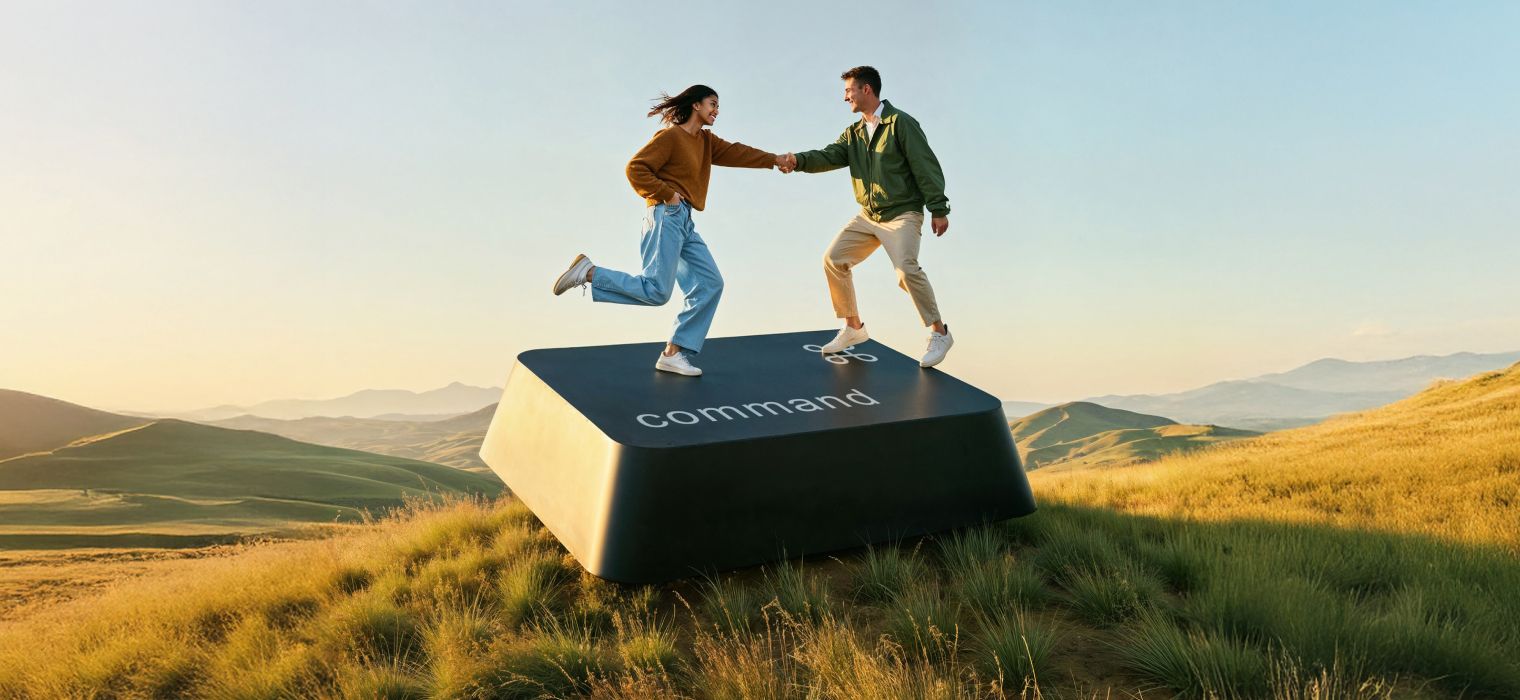
Creativity in command: Proving business impact and getting buy-in
Making work that moves is half the battle. Maybe more than half.
The other half is getting buy-in across the business, so you can guide stakeholders in the right direction, have a greater impact and do more work that matters—building trust through a cycle of creative growth.
For Twilio’s Adam Morgan, VP of Brand, and Nicholas Kontopoulos, VP of Marketing, Asia Pacific & Japan, selling a creative vision and ideas inward starts with a deep understanding of their audience. Paired with masterful storytelling and a powerful brand-to-revenue model, this duo builds the trust, relationships and excitement needed to get company-wide buy-in, which leads to the type of results that give you goosebumps.
“It's about creating an excitement, a buzz, a sense of being able to walk into the room with your head lifted a bit higher and your shoulders back,” said Kontopoulos.
Superside’s Chief Creative Officer (CCO), Gradwell Sears, and Senior Director of Product Marketing, Josh Mendelsohn, echoed the need to balance emotional resonance with measurable performance, digging into how empathy in leadership is a competitive advantage. So, let’s take a look at how these leaders prove impact and get buy-in across the business along the way.
On proving success and getting buy-in from leadership
For creatives and marketers, everything starts with understanding your audience. At the highest levels, that skill becomes a superpower when turned inward towards getting leadership on side and connecting brand narratives to boots on the ground.
Because without leadership buy-in, key creative initiatives from rebrands to quarterly campaigns can become drawn-out, diluted affairs. And without buy-in from in region representatives, even the best brand narratives will lack impact.
But between Morgan and Kontopoulos, they’ve got it covered.
Making creativity make sense
On Morgan’s end, he literally wrote the book on proving the value of creativity to the C-suite. His short answer: “It all depends on what type of person they are, and what they believe in currently.”
He added the caveat of knowing your moment: “The best time to do it is not when there’s heat. Whenever there’s heat, they’re going to say just show me the numbers.”
Given a reasonably temperate environment, Morgan’s practical next step is putting together a presentation for his specific audience in leadership and walking them through the vision. At the end of the day, his goal is, “to share enough emotion that they feel something and they’re in on it.”
The reality is, if they don’t know, they’re going to be worried, and that’s when they’re going to push and probe and ask questions and not trust it. When you say educating them, it’s about building trust and proving to them you’ve got this. You’ve got a vision. You’ve got a good plan.

Kontopoulos then ensures Morgan’s vision gets translated into a story that connects with marketing and sales representatives in region, as well as with regional audiences’ themselves. Having started his career in sales, Kontopoulos excels at understanding both sides of his internal audience, speaking in the quantitative and qualitative terms these parties resonate with.
Part of what we try to do is take Adam’s story and translate that in terms of what it means for us in region and ultimately how it flows into the market, ensuring there’s a red thread running all the way back to that meta story, which we want to tell.

Quantitative, qualitative and distinctive success metrics
So, leadership is bought-in on your creative vision—but how do you prove the impact of that vision and ensure the continued, long-term support brand narratives require to truly succeed?
Kontopoulos spoke to tracking a tapestry of signals, which inform a compelling brand-to-revenue, go-to-market model. In plain English, “How do we tell our story in the market and track that all the way through to booked-won revenue.” He explained that his team is set up to think in that context, encompassing everything from comms and PR to field events.
In quantitative terms, that might include tracking branded keywords, engagement and conversions: Has a creative initiative or campaign led to any measurable uplift?
In speaking to qualitative signals, Kontopoulos lit up, sharing a recent example from a conference in Bangalore. From the keynote to breakout sessions, the booth experience all the way to post-event engagements, Kontopoulos explained how they’d unleashed Morgan’s new brand toolkit with the aim of connecting with the developer community. What gave him goosebumps:
We had folks coming up to our booth saying, wow, love your new branding, it really connects with us. And this is the developer community, the very audience we wanted.

But that qualitative feeling, that buzz, isn’t limited to target audiences or customers. Kontopoulos stressed the importance of how internal teams, from marketing leadership to the sales organization, are feeling and how excitement and buy-in leads to greater employee engagement and results.
Morgan shared a similar experience from Twilio’s recent SIGNAL event in San Francisco. The sales team reported back that big customers sensed a change of feeling—an energy, or in modern parlance, a vibe that the Twilio brand is alive and thriving. The very real impact: Increased deal sizes across all of their sales.
When you hear that, it’s like yeah, it does trickle to sales. And sales is a good indicator. When things are going up and people are feeling it, then the creative’s working.

Morgan pointed to similar quantitative metrics as Kontopoulos, explaining how on a day-to-day basis he looks to branded search and engagement scores, including how many actions audience members are taking once they’re in the Twilio ecosystem. At a higher level, he conducts a brand perception study once a year.
But it was Morgan’s turn to light up when speaking to another, more intangible measurement: Distinctive assets.
In a recent John Lombardo podcast, Morgan recalled hearing the term “distinctive assets,” described as elements unique to a brand that bring higher value than just day-to-day metrics. Think the shape of Coca-Cola’s bottle or their polar bears. A lightbulb moment for Morgan, he believes in building long-term support by thinking bigger than the obvious or tangible measurements and asking yourself, “What distinctive assets can I create that will give us brand value beyond the small metrics?”
Walking the tightrope of performance and brand marketing
If you’re lucky, you might have a CMO like Morgan and Kontopoulos do at Twilio—a leader who understands both brand and performance marketing.
In a role like Morgan’s, that means his CMO, Chris Koehler, doesn’t want to look at a thousand metrics. He’d rather be briefed on the big picture: Two to three key brand metrics. But if a CMO slants more towards performance marketing, you might need to bring in more of those smaller, day-to-day metrics to prove out the value of creative initiatives and campaigns. Again, Morgan stresses the importance of knowing your internal audience when it comes to presenting qualitative and quantitative metrics and getting that all-important buy-in.
Kontopoulos reflected that for a long time, “the SaaS industry overindexed on performance marketing and lost sight of the value and critical nature of investing in brand.” But now, both he and Morgan are seeing the pendulum swing back towards brand, signaling a renaissance of sorts—a revival of creativity and longer-tail strategic thinking.
Tying storytelling to outcomes
Of course, in B2B marketing, sales still drives a lot of the energy. That’s why Kontopoulos emphasizes the importance of internal education. For him, it all comes back to storytelling and translating that story to sales stakeholders.
In its simplest form, that means tying creative initiatives to pipeline and revenue. Kontopoulos explained these numbers, “help them understand the importance of storytelling and how that enables us to widen the conversation we’re having with customers and connect with all the different audiences we need to engage with.”
In other words, getting buy-in downstream is equally important for driving business results—and this is where his collaboration with Morgan plays a critical role:
Having someone like Adam that can bring brand into focus in a much crisper, clearer way, enables us to also translate that into the love language of sales in the field.

A storyteller at his core, Morgan takes a similar approach selling ideas upwards, likening it to how you’d present “the story to the street.” How does that play out? To paint a full picture to leadership, try outlining:
- What’s coming?
- What you’re going after.
- What you’re going to change to get there.
We have to set it up for leadership, rather than just asking them, ‘Hey, what do you think?'

Knowing when to push and when to pull back
Even the best storytellers, the keenest audience observers, will encounter resistance to their ideas on occasion. In these moments, a judgement call comes into play: Whether to push or pull back.
There are times when you read the room, you make an assessment and you go, okay, I’m going to park that one for now. But there are times when you hold your line and you push forward.

When holding the line, Kontopoulos specified it’s helpful to have established trust. He shared the example of a creative direct mail campaign he built targeting key retail accounts in Australia where they sent a safe full of goodies to these accounts, and if they couldn’t crack the code, they’d have to chat with an account executive to get it. The concept was novel to the region—and was met with skepticism by the market’s sales leader.
Having established trust and proven out this strategy in previous roles, Kontopoulos felt confident holding the line. Ultimately, the sales leader agreed, abiding by Twilio’s marketing ethos of nothing ventured, nothing gained. “He trusted me on it, and it turned into one of our most successful direct mailer campaigns. We had customers literally ringing us saying, put us out of our misery. We can’t crack this code. It was like a 44% conversion rate in terms of getting into sales meetings,” Kontopoulos shared.
When met with skepticism, Morgan suggested another approach is to start small: “Try a little media blitz or a social media pilot, then get the trust and go all in.”
But there are also times when pulling back completely is the right move. In Morgan’s experience, once there’s negativity around an idea, it can be difficult to turn the tides. Instead of fighting the direction of that tide, coming up with a new idea can prevent a situation from souring. “There’s an endless well of good ideas,” said Morgan. Plus, taking feedback and reaching back into the well from time to time shows humility and a collaborative spirit.
Build relationships to get buy-in
“Wear the customers’ shoes” is one of Twilio’s values.
Kontopoulos applies it to his internal customers, too. A large part of his success stems from a deep understanding of stakeholders across marketing and sales: The problems they face and the root cause of those issues.
By demonstrating not only how brand ties back to revenue, but how creative solutions address stakeholder problems, Kontopoulos builds the trust and relationships he needs to execute in the highly integrated manner essential to drive impact at a global organization.
Meanwhile, Morgan enables that revenue-driving work by creating a story both leadership and their audience can connect with: One that speaks not just to symptoms, but to root causes as well.
Together, Kontopoulos and Morgan navigate internal storytelling, ensuring conversations about impact are informed by an understanding of long-tail brand strategy—building relationships across the business, trust from top to bottom and confidence in the power of creative.
Education is really important to see the longer tail of what we do. Marketing is a four rolling quarter engine. Our ability to move the needle in quarter is minimal. Sales is engineered to think current quarter plus one at most. There’s a tension there that we’re always having to navigate. At the leadership level, it’s a similar problem.

On the bottom line and leading with empathy
As we’ve seen, creative impact can’t be captured by a single metric or mood.
But it is visible in results—and few understand this balance better than Superside’s Sears and Mendelsohn. Their perspectives show how creative and marketing leaders must harmonize emotional resonance with measurable business performance to drive real impact.
For me it's really all about the results that creative drives… I try really hard to be open to what the data tells me and follow that as long as it's on brand and gets the right message across.

The ROI of great creative
Mendelsohn focuses on data-backed outcomes—whether it’s new leads, downloads or cost per acquisition. But as he acknowledges, he can’t reach those results without great creative.
It’s literally impossible to optimize things like return on ad spend or cost of acquisition without a steady flow of creative to test and learn along the way.

That belief is backed by hard numbers: According to a Forrester Total Economic Impact™ study, by providing highly creative and innovative content in a fast, timely manner, Superside improved campaign performance by $1.1 million over the course of three years. Additionally, Superside’s creative services delivered a 94% ROI—translating to more than $2 million in net value.
This is the marketer’s business case for creative: It’s not optional. It’s foundational to performance. Without it, the machine stalls.
Sears, by contrast, begins with the emotional imprint of creativity. “Creative impact tends to be something that makes you feel something... that prompts an action. That’s what great creative can do,” he said. From impulse buys to iconic campaigns that stay with you for years, Sears champions creativity that isn’t art, but should have a similar vibe.
The longevity of great creative may not show up in immediate ROI… but it’s what turns a bar of soap into something aspirational. That’s the power of brand.

These long-tail effects are often overlooked in quarterly marketing reviews—but they’re the bedrock of brand equity. It’s what makes someone skip over competitors and go straight to your product because they feel something when they see it.
Empathy as a competitive advantage
Empathy isn’t soft. It’s strategic. For both leaders, it’s the secret to aligning marketing and creative priorities and building a partnership that thrives—even under pressure.
I have a sticky note on my desk that says: ‘That's not how I would do it. But that doesn't make it a bad idea.'

This mindset is core to Mendelsohn’s philosophy. Leading with empathy, in his view, means making space for ideas that might not be your own, being flexible on arbitrary deadlines and protecting creative teams from performance pressure.
Sears takes a dual approach—empathy toward team members and empathy toward his audience. He emphasizes understanding what motivates creatives on a human level: “What’s making them excited about this opportunity?” Equally important, he says, is reducing ambiguity in briefs.
Sometimes you get a brief with 15 priorities, which means nothing is.

Lack of prioritization is not a hypothetical concern. In Superside’s Overcommitted Report, creative leaders disclosed that 55% of projects are marked high priority, making it difficult to know where to start. With 76% also experiencing burnout, transparency and protection from scope creep is vital for sustainable creative work.
Managing expectations, particularly in fast-turn environments, prevents burnout and disappointment. Empathy becomes a bridge—between urgency and inspiration, between short-term performance and long-term brand love.
Results matter—but so does the human behind them
Mendelsohn didn’t sugarcoat it: “If you’re kind but don’t deliver results, you're not going to have a job for long.” But he also warned against transferring that pressure to creatives, especially when their strengths lie in storytelling and craft.
When you pass that pressure onto creative teams… it can deliver worse work because it comes from a place of fear rather than inspiration.

The answer? Clear communication, role clarity and shielding creative teams from the metrics heat when needed. Sears echoed this sentiment, pointing to the importance of transparency: “Let them know upfront—this one is two rounds, the templates are there, we just need to get it done.”
Sears also highlighted that while reducing internal friction, clear communication and prioritization is essential to creativity, not every project will be a home run and that’s ok.
Failure isn’t necessarily the worst thing. Most of the time, failure is where you learn the most.

Balancing speed with substance
A recurring tension for creative and marketing leaders is reconciling short-term performance needs with long-term brand equity. For Sears, it’s about recognizing when to swing for the fences and when to take a step back. “This isn’t the one,” he tells his teams sometimes, helping them conserve energy and creative ambition for the right moments.
Mendelsohn offered a complementary take: Even performance marketing must reflect the brand’s emotional core.
The most successful brands are doing both at the same time—performance and brand—through a consistent feeling that permeates everything that gets into market.

Whether you’re running a single email campaign or producing a full-funnel campaign, that consistency is what turns creative volume into brand value.
Where to start: Proving impact with unity
So, what should a creative or marketer do when they’re struggling to prove impact?
Josh’s advice: Tell a unified story.
You need to be accountable for it. When you're explaining your programs and their impact to stakeholders and executives… bring both the marketer and creative together. It has to be a united front.

Start with the why. Translate campaign goals, align on both emotion and action and walk into stakeholder meetings shoulder-to-shoulder.
Gradwell closed on a note of humility and curiosity:
If you're getting it right every time, you're not trying hard enough.

Combine superpowers to command impact
At Twilio, Morgan and Kontopoulos combine their storytelling superpowers with a deep understanding of their internal audiences to not just get buy-in, but build genuine buzz, leading to goosebump-worthy results.
At Superside, Sears and Mendelsohn lead with deep-seated empathy, making space for team members to thrive despite modern pressures, contributing to better creative and co-owning those outcomes.
Both creative-marketing partnerships show you can command even greater impact, together. As Mendelsohn said, “It has to be a united front.” Because united we bring together creativity and empiricism. Resonance and results. The big ideas and the bottom line.
Related resources:
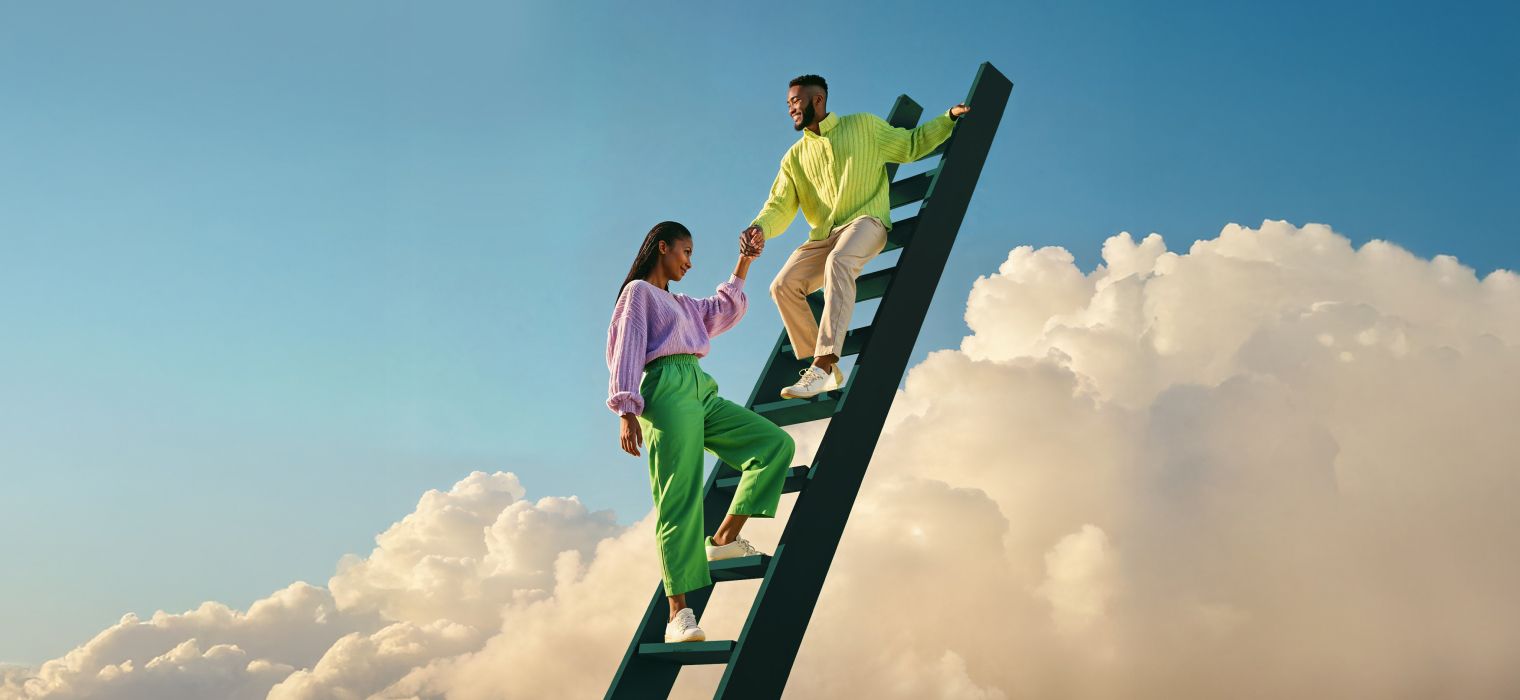
Climb the ladder, collaboratively
From Wistia’s well of inspiring ideas to Leonardo.Ai’s tech-powered possibilities and Typeform’s scalable systems, Superside’s AI-forward approach to Booking.com’s brand-first foundations and Twilio’s stirring storytelling, the red thread is clear: True partnerships—between creative and marketing leaders, experts and AI, brands and vendors—is what leads to industry-shaking, culture-shifting work.
The kind of work we all dream of making. That dream is often tempered by the reality we live in where creative teams are overcommitted while marketing is under intense performance pressure, creating an intrinsic tension between big ideas, and what’s possible.
We touched on solutions throughout this guide: Leveraging AI, building systems and refining operations, prioritizing and focusing on the metrics that matter, and of course, bringing teams into closer alignment.
But at the end of the day, no matter how efficient your systems or how advanced your technology, often, there simply aren’t enough hands to get things done in-house—at the velocity, scale and to the quality standard this modern age requires. This reality requires a new model: One that builds on the fact that true partnerships lead to the best results.
That’s why Superside is spearheading a model where we act as a true partner—an extension of your in-house creative team. We work with leading brands like Wistia, Booking.com and Twilio to help them scale high-impact creative, from ads to videos, without hiring or outsourcing headaches. So, if your creative team could use a creative team, get in touch.





